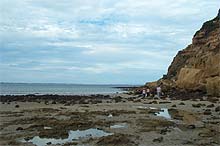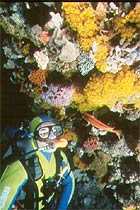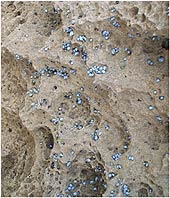|
Rocky Reefs
The information presented here has been written by staff
at the Marine Discovery Centre, Queenscliff, Victoria.
1 Description
Rocky Reefs are fascinating habitats that are rich in life. Many marine animals and plants need to attach themselves to something solid for their survival. In Southern Australia many of our rocky reefs are covered in brightly coloured animals and plants.
Reefs are found where rocks occur above or below the waterline. As the rocks are eroded by the action of water cracks and holes appear which increase the availability of shelter for living things. Different rock types weather in different ways and may have different species. |

Barwon Bluff |
| |
| Rocky reefs that are exposed at low tide are great places to explore as there are many animals and some plants that can survive out of the water for some time. The presence of rockpools, crevices, and boulders increases the diversity of life because of the shelter provided. |
| |
|
|

Kelp forest
Sub-tidal Rocky reefs in southern Australia are characterised
by large communities of marine
plants that attach to the solid rock.
Just like forests on the land, beneath the
surface magnificent forests
of brown kelps
and other marine algae provide homes and food
for many species of animals.
|
Below the low tide mark rocky reefs can support extensive communities of marine plants which can form kelp forests. Reefs that are hidden from sunlight in deeper water, or under ledges, often have brightly coloured communities of invertebrates, many of which rival coral reefs for colour and diversity.
Rocky reefs are also important because they provide habitat for many species of fish, and our two most commercially valuable marine species, the rock lobster and the abalone. |
| |
|
|
Intertidal Rocky Reefs
The animals and plants that live between the high and low tide have to cope with a wide variety of challenges to the survival and live in an environment that is constantly changing. Many species occupy different parts of the shoreline based upon their adaptations and ability to cope with pressures associated with the rise and fall of the tides.
The intertidal rocky shore is an extreme habitat that is in a state of almost constant change when compared with the land or the sea. Because of water movements associated with tides, waves and spray, the conditions affecting different levels on the rocky shore vary continuously throughout the day.
Exposure to air is stressful to marine organisms just as submersion in water is stressful to terrestrial species. Most species on the rocky shore gain oxygen through moist gills and require strategies to ensure gills are kept moist.
|

Sponge gardens
Below the surface of the water, rocky reefs
provide a solid base for animals and plants
to attach. These sponge gardens are made
of filter feeding animals that rely on the rocks
for support and currents for their food. |
| |
|
| |
|

Periwinkles survive in a
very harsh environment |
Not surprisingly, most of the physical stresses affecting marine organisms in this environment are associated with exposure to air and potential desiccation. An additional limiting factor can be exposure to waves that create shear forces on the rocks and could potentially dislodge organisms. Other physical factors influencing distribution could include changes in salinity, dissolved oxygen levels, and substrate type and availability of shelter.
For an organism to survive in any environment, it must meet its food, oxygen, space and shelter requirements. In addition to these, organisms on a rocky shore must be able to tolerate the physical stresses unique to this environment. |
Next - The Physical Environment |
|